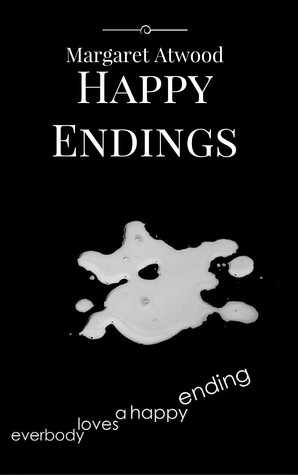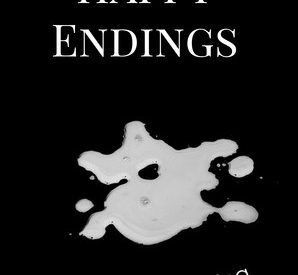Note: This piece was written as a short story analysis for College Writing II, on 21 February 2019
 Image Courtesy of GoodReads
Image Courtesy of GoodReads
Romance stories are timeless tales relatable to almost all age groups. Traditionally, it achieves the purpose of providing the audience with an addictive wave of emotional rush, occasionally offering practical wisdom for couples. However, Margaret Atwood?s ?Happy Endings? is a fictional short story which adopts an ingenious narrative structure to convey a different kind of message. Through utilizing a mixture of second and third person omniscient narrative point of view, Atwood achieves a detached, emotionless narrative which is self-reflective in nature. It ultimately becomes a satirical commentary on its own genre, yet conveys a warming message that it is not the end point that matters in a relationship, but the process.
To begin with, it is worth noting that Atwood makes a bold creative decision to write this piece as a short story, and furthermore choose to break it down more into six sections, simply lettered A through F. Yet, it I s this structure which lends itself well to the narrative perspective, which is monumental in conveying Atwood?s final message. In summary, the short story is about two characters ? John and Mary ? who fall in love with each other. Option A is a happy ending, in which the couple marries and eventually dies together. Options B through F start off drastically different, however regardless of the relationship, it still somewhat ends with death, as illustrated in A. Therefore, this leads the audience to conclude that a love story may be born in a variety of different contexts, yet a successful relationship only has one ending: death. Despite a seemingly morbid conclusion, Atwood has a point. Logically, the only other options are breakup or divorce, and this is in fact Atwood?s point. The audience should not be concerned by the end, the part given the least emphasis in all six endings; rather, the true value lies in the process of how a relationship cultivates. Atwood achieves two things in order to convey this message.
The first is utilizing a third person narrative point of view to create a sense of detachment from the characters, resulting in an emotionless narrative which in turn draws attention to plot structure more than the characters. This is crucial because the purpose of the story is to show, rather than tell the reader the main idea that ?the end is not what matters.? To do so, Atwood must emphasize the repetitive plot structure to allow the audience to observe the pattern. One common thread throughout all of the short stories is that regardless of beginnings, the stories always end with a variation of ?? and everything continues as in A? (Kennedy et al., 258). The main characters are introduced as ?John and Mary,? with no last name and no character development. With a third person point of view, the narrator is able to avoid internal monologue, thoughts and feelings, and therefore the action and plot progression takes up a bulk of the words on the page. The lack of a proper identity constructed results in a main character which is flat and difficult for the audience to relate to and even just see as a realistic person. Whilst this may not be preferable to most writers, here, it allows Atwood to create distance between the reader and each variation of the story. All of this is in stark contrast to traditional romance stories, which makes the message that Atwood tries to convey even more powerful and obvious when all six of these short story variations build up to ?so much for endings. Beginnings are always more fun? (Kennedy et al., 259), a powerful conclusion that extends beyond the text to perhaps inspire the readers in their own narratives of life.
Atwood?s mastery does not just stop here, but in fact begins with her introducing the second person narrative point of view at the very beginning. The introduction to stories A through to F is a direct address to the readers, suggesting ?if you want a happy ending, try A? (Kennedy et al., 257). The most immediate effect this has is it raises the question of who this ?voice of god? narrator is. A likely option is perhaps the writer herself, as if in the process of creating a short story, unsure of which direction to take it. The fourth wall is usually never broken in stories as it shatters the illusion that the reader is part of the narrative. Atwood uses this very effect to draw attention to the writing process of a story, conditioning the readers to think about aspects such as genre conventions and clichs of a romance story, which are later introduced. Examples are such as in variation C, when James is supposedly the more desirable lover ?who has a motorcycle and a fabulous record collection? (Kennedy et al., 258), or variation E when Fred and Madge live a desirable life in ?their charming house ? by the seashore? (Kennedy et al., 259). The interaction between the second and third person narrative perspectives is what creates the self-aware type satire that is present throughout the text. As an effect, on one hand, the third person narrator creates a traditional romance drama, but at the same time, the second person narrator shows an unamused and all-knowing attitude towards the entire romance genre in which plot development is propelled by clich after clich.
Another effect the second person narration has is it forces the reader to engage with the text, almost like a choose-your-own-adventure style story, where conventionally the audience is given the illusion that they are in control, but in fact, the story is obviously pre-written and have pre-planned endings. Story E even goes as far as to tell the reader that if ?you like, it can be ?Madge,? ?cancer,? ?guilty and confused,? and ?bird watching?? as alternative elements to freely insert and replace parts of the existing plot. It seems as if even the writer or narrator are not taking their own plot seriously, so long as it ends with a ?happily-ever-after? death. This also contributes to the self-aware and satirical tone that is previously discussed. Both of these effects also lead the audience to correctly conclude that life has two endings ? a happy one, and a sad one. What makes a story interesting is not the binary ?what,? as Atwood would call it, but the infinite possibilities of ?How and Why? (Kennedy et al., 259).
As a reader, my biggest question after reading the story multiple times is where the conflict in this short fiction lies, because it can be felt, but not pin-pointed, for whatever reason. And then it hit me. Atwood?s literary goal is perhaps to create a detached, emotionless narrative to showcase her mastery and communicate her view of romance and life. But the ultimate goal of the short story is to inspire self-reflection from within the reader. And so I conclude that the conflict lies not within the text but in our own lives. All of us are a version of John, a blank canvas of a human being, unique only because of our life experiences. All of us will encounter a Mary at some point in our lives, our love interest. Our conflict is any obstruction to reaching ending A, a happy death. And Atwood wants us to pay attention to how we overcome these obstacles, because if we succeed, the end does not matter ? we know what comes already because Atwood spoiled the surprise for us. The lesson to be learned from ?Happy Endings? is we should instead pay attention to savoring what is left, before the inevitable end comes.
What is ingenious about Atwood?s writing is perhaps how her craft hides in plain sight. Atwood subverts the traditional usage of elements like genre conventions, narrative points of view, and characterization to accomplish the opposite effect of what regular writers strive for, in turn showing an even higher degree of understanding of these techniques.


